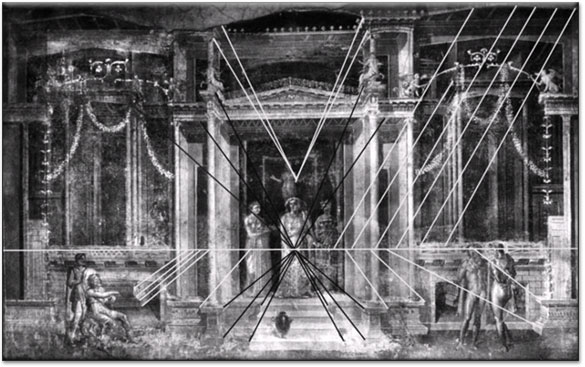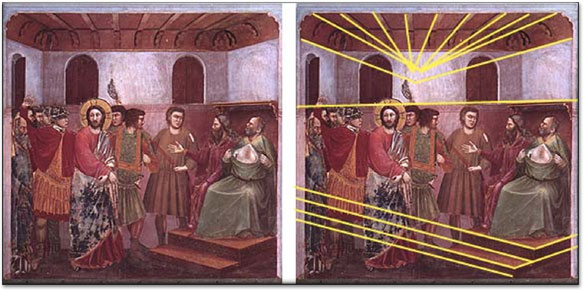The Role of Perspective in Shaping the Renaissance

epth representation, in both its geometric and its more generic forms, has
often served as an impetus in artistic development through the millennia.
The first historical mentions of art, by Plato and contemporaries in the 5th
century BC, were provoked by the dramatic use of perspective in the scenery
for the plays of Aeschylus and Sophocles. One of these innovative scene painters,
Agatharchus, even wrote a commentary on his use of convergent perspective,
whose effects had inspired several contemporary Greek geometers to analyze
the projective transform mathematically. Did this early focus of excitement
lead to a general understanding of perspective?
No examples of Greek perspective paintings survive, but we
can perhaps glean a sense of their technique from Roman copies (probably by
Greek painters) from the ruins of Pompeii in the first century AD. The example
shown in Fig. 1 gives a vivid impression of a three-dimensional portico as a
backdrop to the myth of Orestes. The depth is conveyed by shadows and interposition
as well as the linear perspective of the angles of the horizontals. By the principles
of central projection, all horizontal structures running into the distance away
from the plane of the picture should project to a single central vanishing point.
Little (1971) has argued that painting from this period does show accurate adherence
to this perspective principle. We may test this idea by performing a careful
analysis of the projection geometry of all the receding horizontals, as is illustrated
in Fig. 1.
 |
| Fig. 1. Pompeiian mural of the pageant
of Orestes, 2nd century AD, containing both central convergence (black
lines) and ‘fishbone’ parallel convergence for the peripheral
features such as the roof rafters (white lines). |
 |
The black construction lines illustrate that the central structures adhere
accurately to a single vanishing point close to the viewer’s eye level
(estimated as horizontal light line). The light construction lines drawn from
the rafters in the roof visible at the upper right, and from other edges distant
from the center, illustrate that there was no principled adherence to a central
vanishing point. The lines from distant receding horizontals are in roughly
parallel perspective in each quadrant, giving a reasonable impression of appropriate
perspective but betraying a lack of understanding of the core geometric principle.
This level of ability (which is typical of the era) implies that the Greek
and Roman painters could evoke astonishing levels of three-dimensionality
in their murals but did so from an intuitive grasp of the convergence concept
rather than a fully accurate construction.
Not only in the Roman era, but subsequently in the 14th century, painters
such as Cimabue, Giotto and the Lorenzetti brothers were struggling with the
concepts of linear perspective. Evidently aware of its profound visual impact,
their progress toward a more coherent approach to geometric perspective seemed
to spark the eloquent visual representation that is the hallmark of Renaissance
art. One of the first uses of perspective was in Giotto’s ‘Jesus
Before the Caïf’ (Fig. 2A), more that 100 years before Brunelleschi’s
perspectival demonstrations galvanized the widespread use of convergent perspective
of the Renaissance proper.
 |
| A |
B |
| Fig. 2A. ‘Jesus
Before the Caïf’, by Giotto (1305). The ceiling rafters show
the Giotto’s introduction of convergent perspective. B. Detailed
analysis, however, reveals that the ceiling has an inconsistent vanishing
point and that the Caïf’s dais is in parallel perspective,
with no vanishing point. |
 |
Geometric analysis (Fig. 2B) reveals that Giotto had implemented the idea of
convergent parallels without the use of an accurate vanishing point. The rafters
in the ceiling all converge in a convincing fashion, but geometric projection
exposes the failure to converge accurately. The deviation is scarcely noticeable
in the original fresco, so Giotto had a good eye in this instance. The minor
misconvergence is, however, sufficient to document that Giotto did not use a
vanishing point in his construction of the ceiling. His dramatic evocation of
depth in this picture was therefore based on either a non-geometric construction
principle or a different form of construction that did not involve the use of
vanishing points.
Inspection of the picture also reveals a curious bowing of the back wall
forward, both implied in geometry of the wooden cornice and induced by the
shading on the stucco wall. The main reason for the bowing of the cornice
seems to be that the rough vanishing point for the ceiling is much higher
than for the shelf at right, which should also project to the same location
(see Fig. 2B). This discrepancy reveals that the convergence of the beams
is steeper than is required by accurate geometrical perspective. To illustrate
this point, one can adjust the convergence of Giotto’s picture to a
point where the convergences are all in a correct perspective relation. Strictly,
this requires a central vanishing point and two lateral vanishing points for
the two angles of the Caif’s dais. By the rules of perspective, these
lateral vanishing points must be on the same level as the central one. A modified
image that conforms to these constraints in provided in Fig. 3. It is evident
that the cornice no longer seems to bow forward, but looks like a square room
in natural depth.
